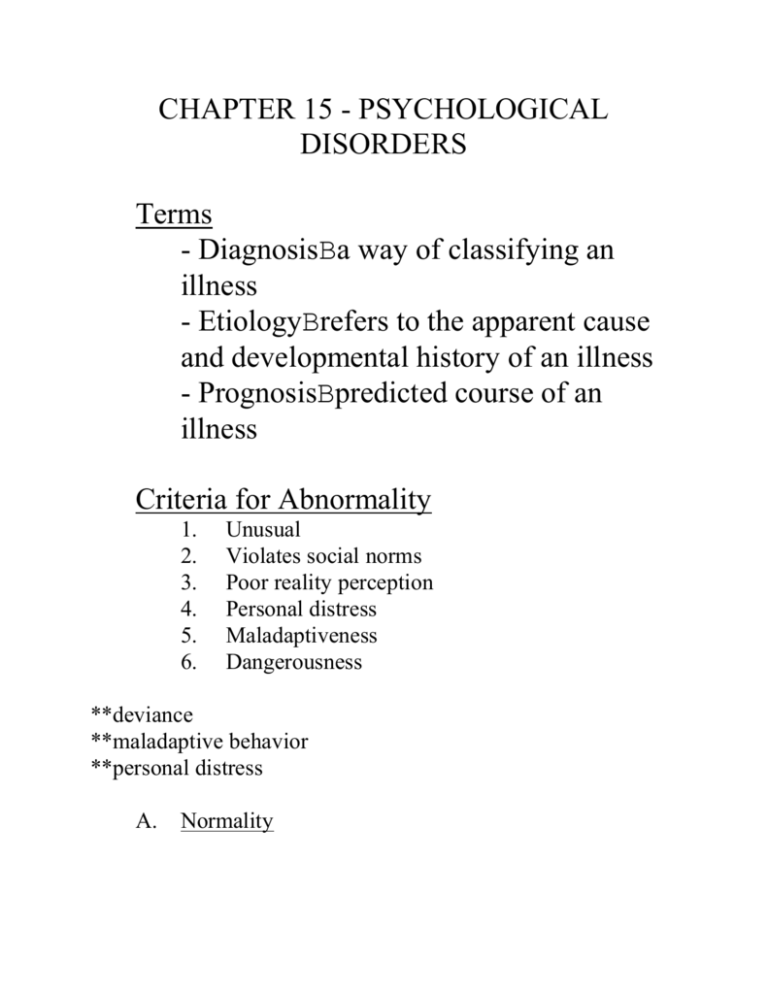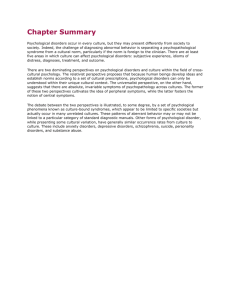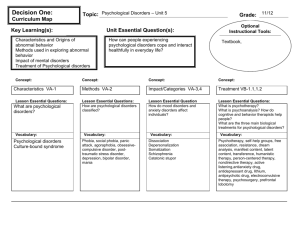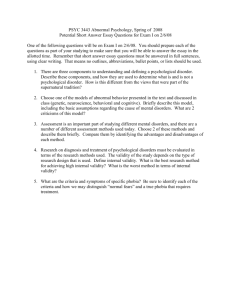CHAPTER 15 - PSYCHOLOGICAL DISORDERS
advertisement

CHAPTER 15 - PSYCHOLOGICAL DISORDERS Terms - DiagnosisBa way of classifying an illness - EtiologyBrefers to the apparent cause and developmental history of an illness - PrognosisBpredicted course of an illness Criteria for Abnormality 1. 2. 3. 4. 5. 6. Unusual Violates social norms Poor reality perception Personal distress Maladaptiveness Dangerousness **deviance **maladaptive behavior **personal distress A. Normality B. Classification Diagnostic and Statistical Manual (DSM) DSM-IV - multiaxial system Axis IB clinical syndromes Axis IIB personality disorders & mental retardation Axis IIIB general medical conditions Axis IV Bpsychosocial and environmental factors Axis VB Global Assessment of Functioning (GAF) C. Medical Model: Abnormal behavior = a disease II. Anxiety A. Generalized Anxiety Disorder B. Phobias C. Panic Disorder D. Agoraphobia E. Obsessive-Compulsive Disorder - Obsessions = thoughts - Compulsions = behaviors F. Post-Traumatic Stress Disorder Etiology of Anxiety Disorders 1. 2. 3. 4 Biology Learning History - Mowrer's Two-Factor Theory Child-Rearing Cognitive Factors Mood Disorders Depressive Disorders Bipolar Disorders (Manic Depressive) Etiology of Mood Disorders Biological predisposition Neurochemical factors Cognitive factors Personality Precipitating stressor (diathesis stress) Substance Related Disorders Substance AbuseB a maladaptive pattern of substance use leading to impairment or distress Substance Dependence Criteria 1. Psychological dependenceBrepeated use despite significant related problems 2. Impairment in social or work functioning from use 3. Physiological dependence (tolerance & withdrawal) 4. various substances Etiology 1. 2. Physiological Psychological Eating Disorders A. Anorexia NervosaB $ B. prevalence rates: .5 to 1% of young women Bulimia Nervosa $ prevalence rates: 1% to 3% among young females $ highly culturally specific: Etiology of Eating Disorders A. Biological Dimensions --NOT precipitating anorexia, but do play a role in maintaining anorexia Bgenetic factors Bneurotransmitters B. Socio-cultural factors $ link between self-worth, happiness, and success and physical appearance, especially for white women $ dieting culture C. Family Influences D. Psychological Factors anorexia: avoidance of harm, perfectionism, low novelty bulimia: mood swings, less impulse control Treatment for Eating Disorders Somatoform Disorders - Somatoform disorder = physical problems with psychological origin - Psychosomatic disorders = physical problems with physical and psychological bases - Malingering = faking an illness Somatization Disorder Conversion Disorder Hypochondriasis Etiology of Somatoform Disorders 1. 2. Biology Personality Dissociative Disorders - Loss of sense of identity, via loss of memory or consciousness Psychogenic Amnesia Psychogenic Fugue Dissociative Identity Disorder - Etiology of Dissociative Disorders 1. 2. 3. Severe stress (childhood trauma) Avoid facing problems by repressing their existence Ability to hypnotize self Schizophrenia - Split Mind **Cognitive Disturbance - Poor Reality Contact Course of Schizophrenia Prodromal phase Acute phase Residual phase Etiology of Schizophrenic Disorders 1. Physiological - genetic predisposition - increased dopamine activity - neurological defects? 2. Psychological - Fragmented communication in the family - High expressed emotion Personality Disorders C rigid, maladaptive, extreme personality patterns Anxious/Fearful cluster 1. Avoidant 2. Dependent 3. Obsessive-Compulsive Odd/Eccentric cluster 1. Schizoid 2. Schizotypal 3. Paranoid Dramatic/Impulsive cluster 1. Histrionic 2. Narcissistic 3. Borderline 4. Antisocial Etiology 1. Genetic Predisposition 2. Poor socialization 3. Lack of consistent limits Suicide Prevalence - Tenth highest cause of deaths in US - Underestimated - accidents - Outranks murder Demographics 1. Sex 2. Age 3. Marriage 4. Occupation Myths - Only committed by people with severe psychological disorders - People who talk won't do it - Suicides usually occur with no warning - Suicides really mean to die







